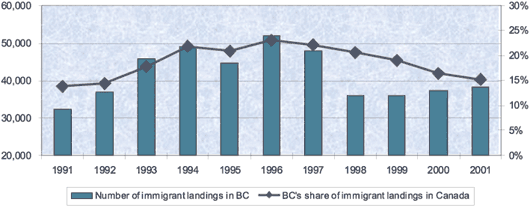|
Immigration and Multiculturalism — Continued
Goal: The social and economic benefits of immigration and multiculturalism
are maximized
Planning Context
British Columbia continues to be a major immigrant-receiving
province, though our share of immigration peaked in the mid-1990s.
Immigration to British Columbia is currently about 15 per cent
of the national total. This is not expected to change over the
next few years.
Immigrant Landings in British Columbia 1991
– 2001

Many immigrants arrive in British Columbia with little understanding
of how to secure housing, how the job market functions, and how
the legal, transportation, banking, education, and health systems
work. About one-half of immigrants arriving in the province do
not speak English at landing.
In 1998, 35 per cent of new arrivals held bachelor or graduate
degrees; 40 per cent had secondary school or less. Many immigrants
arrive with intended occupations in the regulated professions
and trades. However, often they experience difficulty getting
their foreign credentials recognized by provincial regulatory
bodies and licensing authorities.
| Objectives |
Key Strategies |
| 1. Stronger communities
through action on racism and greater awareness of multiculturalism. |
• Respond to incidents of racism and hate.
|
| 2. Accelerated settlement
of immigrants allows them to realize their full potential
and contribute to the economy. |
• Develop performance-based standards and provide funding
for third-party service providers of immigrant settlement
services.
|
| 3. Increased and expedited
immigration with emphasis on skilled immigrants helps meet
skill shortages. |
• Manage international qualifications program.
• Manage the Provincial Nominee program.
• Renegotiate the Canada/BC Agreement for Cooperation on
Immigration.
|
|
